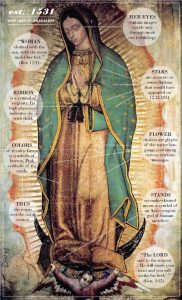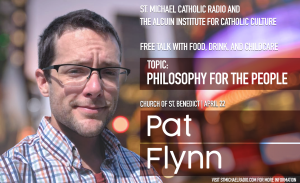6 Miracles You Might Not Know About
As you read the Bible, you come across a ton of miracles in the Old and New Testament (We actually list the Bible verses at the bottom – you should check it out). But because these miracles happened thousands of years ago, many lose or perhaps question the “wow factor” in this high-tech “understood” modern world.
Definition of a Miracle:
The Catechism of the Catholic Church defines “miracle” as: A sign or wonder, such as a healing or the control of nature, which can only be attributed to divine power. The miracles of Jesus were messianic signs of the presence of God’s kingdom. (Glossary “Miracle”)
The key here is the notion that a true miracle “can only be attributed to divine power;” it cannot be explained by the action of created beings. Thus, when the Church investigates whether or not a particular phenomenon is miraculous all natural possibilities must first be eliminated. In fact, in its discernment process the Church will often use non-believing experts in pertinent areas, whether they are doctors when discerning a physical healing, or various scientists when examining some other material phenomena as we will see below, in order to avoid any possible bias in favor of demonstrating a miracle. If anything, the Church would prefer the investigating expert to have a bias against rather than in favor of demonstrating an authentic miracle. The principle involved here is simple. God does not need our help to communicate miracles. He is plenty able to do it all by himself and in a way that will be convincing to any and all who seek the truth honestly.
Why Miracles?
Vatican I, in session 3, The Dogmatic Constitution on the Catholic Faith, chapter 3, “On Faith,” declared:
Nevertheless, in order that the submission of our faith should be in accordance with reason, it was God’s will that there should be linked to the internal assistance of the Holy Spirit external indications of his revelation, that is to say divine acts, and first and foremost miracles and prophecies, which clearly demonstrating as they do the omnipotence and infinite knowledge of God, are the most certain signs of revelation and are suited to the understanding of all.
Moreover, in its accompanying canons, the Council fathers declared infallibly:
(Canon 3) If anyone says that divine revelation cannot be made credible by external signs, and that therefore men and women ought to be moved to faith only by each one’s internal experience or private inspiration: let him be anathema.
(Canon 4) If anyone says that all miracles are impossible, and that therefore all reports of them, even those contained in sacred scripture, are to be set aside as fables or myths; or that miracles can never be known with certainty, nor can the divine origin of the Christian religion be proved from them: let him be anathema.
It should be noted that God does not overwhelm us when it comes to miracles. God respects our freedom. Indeed, without freedom there is no true love as we understand it. Miracles are aids to those who honestly seek truth, never guns to the head forcing belief. For those who do not want to submit to God and his truth, there will always be ways to explain away miracles, even if these “explanations” range from the weak to the absurd. Jesus’ words in Luke 16:31 come to mind:
“If they do not hear Moses and the prophets, neither will they be convinced if someone should rise from the dead.”
This is not to dismiss the importance of miracles. Of course not! The Church has rightfully declared them to be “the most certain signs of revelation” and certain proofs of “the divine origin of the Christian religion” as we cited above. But it is a help for keeping things in perspective. Not everyone is going to be convinced because there is more to this thing than just being persuaded intellectually. The will sometimes gets in the way!
NOW ON TO THE MIRACLES!
1. SAINT PADRE PIO (1887-1968)
Francesco Forgione was an Italian priest later canonized into sainthood as Saint Pio of Pietrelcina and was famous for his stigmata (mysterious wounds in the hands, similar to the ones Jesus sustained during crucifixion). Although he himself was embarrassed by his affliction, his wounds garnered him a lot attention from the religious and secular. Physicians were fascinated by his wounds because although always present, never grew infected. You can read more in depth here.
Side Note: Saint Padre Pio died in 1968. His body is still on display incorrupt. Watch this video:
2. THE MIRACLE OF THE SUN (1917)
Keep in mind… this was less than 100 years ago. In Cova da Iria fields, Portugal, as many as 100,000 people assembled in order to view a miracle prophesied by three shepard boys. All who were there claim that after a fit of rain, the clouds opened and the sun appeared brighter than usual. It then began to move in a slow zig-zag pattern. People who were wet from the rain said their clothes dried instantly and believed this either to be a sign of God’s love, or the end of the world as we know. Many atheist reporters witnessed this event and did not know how to describe the event when asked to write a news story. You can read more about this here. Wikipedia says this.
3. THE APPARITION AT KNOCK, IRELAND. (1879)
In the small Irish village of Knock there were reportedly sightings of biblical figures illuminated outside the local church. Two women (both named Mary by the way) saw the figures, and when they got closer realized it was The Virgin herself, along with St. Joseph and St. John the Evangelist. One of the Mary’s went to get the rest of the town, and when they arrived an alter appeared with a young lamb laying on top. It was made an official apparition by the Pope in 1979. You can read more here
4. THE APPARITIONS AT GUADALUPE (1531)
Mary also appeared to a man named Juan Diego on a small hill near Mexico City called ‘Tepeyac hill’. She told Diego that she loved the people of Mexico and wanted Diego to tell the local bishop to build a church on the hill. As proof to the bishop she asked Diego to carry some flowers to him in his tilma (like a robe). When he took out the flowers the bishop and Diego were shocked to see a mysterious imprint of Mary on the fabric. You can read more here
5. MIRACLE OF LANCIANO (700 AD)
Although this miracle took place more than a thousand years ago, it actually wasn’t confirmed as a miracle until 1971. Supposedly in a town in what is now Lanciano, Italy lived a monk who doubted the presence of the Lord the Eucharist. One day as he was saying the Words of Consecration, the bread literally turned into human flesh and the wine into blood. In 1971 some professors of the University of Vienna confirmed that the host was in fact human flesh which coagulated into five globules for each one of the wounds Jesus sustained on the cross and the wine was indeed blood, type AB. The elements can still be seen today! The flesh, which is the same size as the large host used in the Latin Church, is fibrous and light brown in color and becomes rose-colored when lighted from the back. The blood has an earthy color resembling the yellow of ochre. Read more here
6. STATUE IN AKITA (1973)
In 1973 Japan Sister Agnes Katsuko Sasagawa began having visions of the Virgin Mary and slowly the appearance of a cross shaped wound started forming on her hand. One night the wound starting burning painfully, she heard a voice coming from the statue of the Virgin Mary in the chapel. Later, a few other sisters noticed the statue was bleeding from the hand and started weeping. The statue continued weeping at an interval of 8 months on 101 occasions.
You can read more here
Here are some more Eucharistic Miracles: Click Here
Note – there are many more saints and miracle we did not mention. I will leave you with a quote from Jimmy Akins, “The Fathers Know Best: Your Essential Guide to the Teachings of the Early Church”
“Does God still do miracles? Virtually all Christians would answer yes, he does. Otherwise there would be no point in praying to him for help in this life. But God can work subtly or dramatically, and there is a difference between, for example, how God might help you find a spouse and the parting of the Red Sea. One type of divine intervention does not obviously override the way nature normally operates; the other does.
As a result, some Christians have questioned whether God still does the kind of miracle that is overtly supernatural in origin—something that nature does not do on its own—and some have argued that the “age of miracles” of this kind is over, though Scripture neither claims nor predicts this.
In fact, overtly supernatural miracles have been reported down through history. Historian Ramsay MacMullen notes that contemporary miracles played a central role in Christian apologetics in the early centuries:
When careful assessment is made of passages in the ancient written evidence that clearly indicate motive … leading a person to conversion, they show (so far as I can discover): first, the operation of a desire for blessings … second, and much more attested, a fear of physical pain … third, and most frequent, credence in miracles (Christianizing the Roman Empire, 108).
Christian writers themselves … portray the learned and sophisticated as having been won over by sheer force of logic, and the unlearned, by a sort of stupefaction or terror before the greatness of God’s power (ibid., 109).
The Church Fathers, for their part, certainly recognized the ongoing, miraculous operation of God in the world.”
Church Fathers and Miracles:
St. Ambrose of Milan
“As I do not wish anything which takes place here in your absence to escape the knowledge of your holiness [my sister], you must know that we have found some bodies of holy martyrs. . . . We found two men of marvelous stature, such as those of ancient days. All the bones were perfect. . . . Briefly we arranged the whole in order, and as evening was now coming on, transferred them to the basilica of Fausta, where watch was kept during the night and some received the laying on of hands. On the following morning we translated the relics to the basilica called Ambrosian. During the translation a blind man was healed. . . . [Arians] deny that the blind man received sight, but he denies not that he is healed. He says: ‘I, who could not see, now see,’ and proves it by the fact. . . . He declares that when he touched the hem of the robe of the martyrs, wherewith the sacred relics were covered, his sight was restored” (Letters 22:1–2, 17 [A.D. 388])
St. John Chrysostom
“[I]n our generation, in the case of him who surpassed all in ungodliness, I mean [the Emperor] Julian, many strange things happened. Thus, when the Jews were attempting to raise up again the temple at Jerusalem, fire burst out from the foundations and utterly hindered them all; and when both his treasurer and his uncle and namesake made the sacred vessels the subject of their open insolence, one was eaten with worms and gave up the ghost, the other burst apart in the middle. Moreover, the fountains failing when sacrifices were made there and the entrance of famine into the cities together with the emperor himself was a very great sign. For it is usual with God to do such things when evils are multiplied” (Homilies on Matthew 4:2 [A.D. 391]).
Pope Gregory I
“I determined, through the aid of your prayers for me, to send . . . a monk of my monastery for the purpose of preaching [to the heathen in Anglia]. And he, having with my leave been made bishop by the bishops of Germany, proceeded with their aid also to the end of the world to the aforesaid nation, and already letters have reached us telling us of his safety and his work, to the effect that he and those that have been sent with him are resplendent with such great miracles in the said nation that they seem to imitate the powers of the apostles in the signs they display. Moreover, at the solemnity of the Lord’s nativity [Christmas] which occurred in this first indiction, more than ten thousand Angli are reported to have been baptized by the same, our brother and fellow bishop” (Letters 30 [A.D. 597]).
“I have given some instructions to Boniface, the guardian who is the bearer of these presents, for him to communicate to your holiness in private. Moreover, I have sent you keys of the blessed apostle Peter, who loves you, which are wont to shine forth with many miracles when placed on the bodies of sick persons” (ibid., 26).
Miracles in the Bible:
OT Ge 1:1, 3, 6, 9, 14, 20, 24–31, 2:9, 9:12, Ex 13:21, 16:8, 24, Nu 17:8, 21:9, Jos 3:16, 6:20, 10:12, Jdg 15:19, 1 Ki 17:6, 9, 17, 19:6, 8, 2 Ki 2:14, 19, 4:1, 34, 38, 5:14, 6:6, 13:21, Is 38:21, Da 3:23, 6:22, Jon 4:10
NT Mt 17:25–27:66, Lk 7:18–23, Ac 2:22, Jn 2:1–11, 4:46–5:16, 10:31–38, 11:11–44, Mt 8:23–34, 11:5–6, Lk 7:1–16, Jn 5:36, 10:25, Mt 14:13–33, 15:32–39, Mk 5:25–43, Jn 14:11, 15:24, 21:1–24, Mt 8:1–4, 14–17, 9:23–26, 11:25–30, 12:9–13, 22–23, 15:21–28, 17:14–22, 28:2, Mk 1:23–26, 32–34, 2:1–12, 6:55–56, 7:31–37, 8:22–26, 11:12–14, Lk 5:1–11, 6:19, 9:12–17, 13:11–17, 14:1–6, 17:11–19, 22:49–51, Jn 9:1–41, Mk 3:22, 10:52, 16:17, 20, Lk 2:7, 19:8, Jn 6:5–15, 8:34–36, 11:47–48, 12:28, 15:16, 18:36, 20:7, Ac 19:13–16, 1 Co 12, Heb 2:4







